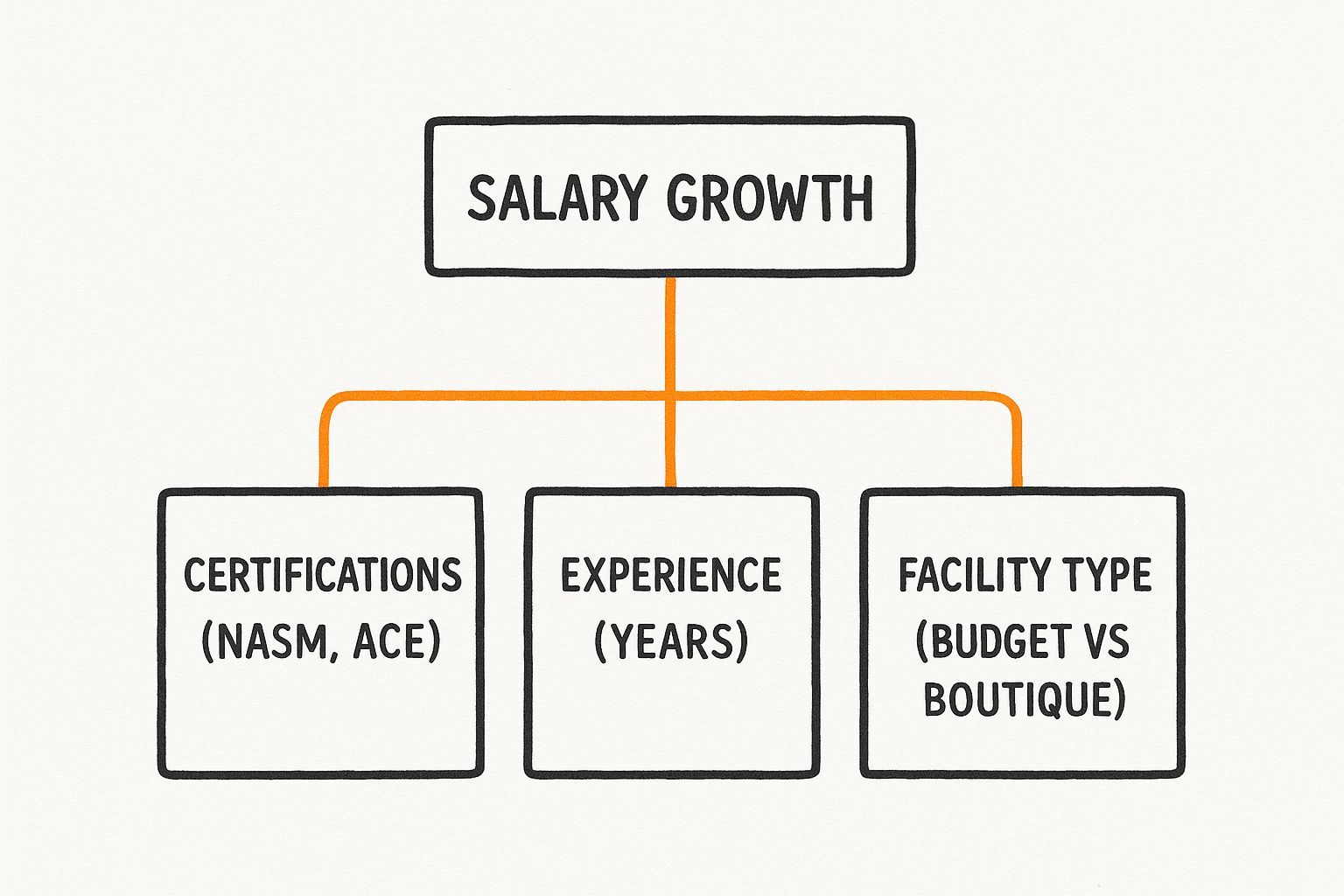Wondering how much do fitness instructors make? Learn about average earnings, income factors, and tips to boost your fitness career income.
This article is proposed by Gymkee, the personal trainer software that allows you to deliver the best coaching experience to your clients while saving time and growing your personal training business.
Try Gymkee for free for 14 daysYou want to know how much fitness instructors make. Let's get straight to the numbers.
According to the U.S. Bureau of Labor Statistics, the median annual salary for a fitness instructor is $46,180, or about $22.20 per hour. But that median figure is just a starting point.
Top earners in high-demand markets can clear over $80,000, while a new instructor at a commercial gym might start around $27,000. The difference isn't luck; it's strategy. This guide breaks down the data and provides practical advice to help you maximize your income.

A fitness instructor's salary isn't a fixed number. It's a direct reflection of your skills, reputation, client base, and business strategy. Your income is shaped by where you live, who you train, and how you structure your career.
Before we get into how to increase your pay, let's establish a clear baseline with sourced data.
This is a straightforward breakdown of typical earnings for fitness instructors in the United States, based on official government data.
The hourly rate is a key metric for part-time instructors or those building a client base, while the annual salary reflects full-time work.
Your income journey will likely follow a clear progression as you gain experience and build a reputation.
Here’s a practical look at that path:
The industry outlook is strong. The BLS projects that employment for fitness instructors will grow by 14% between 2022 and 2032, which is much faster than the average for most occupations.
This growth means more gyms, more clients, and more opportunities for dedicated professionals to build a profitable career. You can discover more career outlook statistics on the Bureau of Labor Statistics website.
These numbers are your foundation. The following sections detail the specific factors that will help you move from the median salary to the top of the pay scale.
Why does one instructor make $35,000 a year while another in the same city earns six figures? The difference comes down to a handful of strategic variables that directly control your income. Understanding these factors is the first step toward taking control of your earnings.
Your base certification is your entry ticket. Advanced credentials are your leverage for higher pay.
Holding a certification from a respected, NCCA-accredited organization like the National Academy of Sports Medicine (NASM) or the American Council on Exercise (ACE) immediately boosts your credibility. These aren't just pieces of paper; they demonstrate a foundational understanding of exercise science.
Specialized certifications in areas like corrective exercise, nutrition coaching, or strength and conditioning allow you to command higher rates. Clients pay a premium for an expert who can solve a specific problem, whether it’s training around an old injury or preparing for a competitive event.
The infographic below illustrates how certifications, experience, and your place of work combine to determine your salary.

Mastering each of these three areas is what elevates your earning potential from a standard wage to a significant income.
Experience is more than just time in the industry; it's a proven track record of getting results.
A new instructor might start at $20-$25 per session at a commercial gym. A seasoned professional with five years of client success stories can command $75-$100 or more for the same hour.
As you gain experience, you build a reputation. Word-of-mouth referrals become your most effective marketing tool, creating a steady stream of clients willing to pay more for your expertise. Your portfolio of client transformations and testimonials is undeniable proof of your value.
Your income potential as a fitness instructor is directly tied to the results you deliver. A strong reputation built on client success is your most valuable asset. It allows you to move from being a commodity to a sought-after expert.
Where you work directly impacts your pay structure. Each environment has clear financial pros and cons.
To build a strong foundation for any of these paths, you can explore an effective personal trainer course designed to teach you the fundamentals from day one.

The title "fitness instructor" covers multiple career paths, each with its own client base and earning potential. Your income is directly tied to the path you choose. Let's break down the most common specializations to see how they compare.
Group fitness instructors lead classes like HIIT, spin, and aerobics. Their pay is typically a flat rate per class, which varies based on the gym's pricing and class attendance. This route offers a predictable schedule, but the per-hour earnings often have a lower ceiling. To succeed, you must build a loyal following that consistently fills your classes.
Personal trainers design customized workout and nutrition plans for one-on-one clients to achieve specific goals. In this role, your income is a direct reflection of your ability to deliver measurable results. You are typically paid per session or by selling packages. While hourly rates can be much higher than in group fitness, this path demands intense personal focus and schedule flexibility. Group fitness instructors earn a median salary of $42,401, whereas personal trainers earn a median of $62,288, according to recent industry data. For a deeper dive, learn more about fitness instructor pay data.
Specialization in a discipline like Yoga or Pilates allows instructors to command premium rates. These fields require years of dedicated training and attract clients willing to pay more for specific expertise. These instructors often work in dedicated studios, wellness centers, or build their own private practice, combining per-class fees, private session rates, and workshops to create multiple revenue streams.
Specialization is a powerful income driver. When you become the go-to expert for a particular niche, you stop competing on price and start commanding rates based on your unique value.
Online coaching removes geographical limitations, allowing you to train clients from anywhere and creating the highest potential for scalable income.
Common online business models include:
This path requires a different skill set, including digital marketing, content creation, and the ability to build a strong personal brand online.

Where you work is one of the biggest financial decisions you'll make. The same training session can command a dramatically different price depending on the zip code, a direct reflection of local economics. An instructor in a small town and one in a major city serve entirely different markets. The city-based coach has a higher cost of living, which necessitates higher rates to build a sustainable career.
Major cities concentrate high-paying jobs, creating a large pool of clients with disposable income who are willing to invest in premium wellness services. This drives up demand for top-tier instructors, creating a competitive market where the best coaches can charge significantly more. The data supports this. The average hourly pay for a personal trainer can range from $14.99 to over $55.00. Major hubs like Chicago and New York command some of the highest rates in the country, at $38.26 and $35.21 per hour, respectively. You can explore more detailed personal trainer income data to compare markets.
This table shows the clear differences in earning potential across several major U.S. cities.
The income gap between Chicago and Houston is nearly $30,000 annually for the same job, highlighting the financial impact of location.
Your location sets the ceiling for your earning potential. While skills are crucial, the local market ultimately determines the rates clients will pay and gyms can offer.
Choosing where to work is a strategic decision. A higher salary in a big city must be weighed against the increased cost of living and competition. A smaller city may offer a lower income but a more affordable lifestyle and an easier path to becoming a local expert.
High-earning instructors don't get there by accident. They treat their careers like a business and make strategic moves to increase their value and income. These are actionable, field-tested strategies that separate top earners from the average.
General fitness is a crowded market. The fastest way to increase your income is to become a specialist. Focusing on a specific client type or training style makes you the go-to solution for a particular problem, and people pay a premium for specific solutions.
Consider these high-demand niches:
Your personal brand is your professional reputation. It's what makes a potential client choose you over other trainers. Building a brand means consistently showcasing your expertise, training philosophy, and client results.
Start simply. Choose one or two social media platforms and share genuinely valuable content, such as practical tips, client success stories, and insights that demonstrate your unique approach. This builds trust and positions you as an authority, attracting clients who are already convinced of your methods.
A strong personal brand turns you from a commodity paid by the hour into a sought-after expert who can command premium rates. It’s the difference between chasing clients and having them come to you.
Trading time for money has a hard limit. The highest-paid instructors overcome this by creating income streams that are not tied directly to their time. Online programs are an effective way to do this. Instead of only coaching in person, you can package your knowledge into digital products that sell repeatedly.
Here are a few proven models:
Developing these offers allows you to help more people and increase your income without working more hours. To market your offers effectively, you can explore viral video marketing strategies specifically for fitness professionals. Setting the right price is critical, and this guide on online fitness coaching pricing offers a detailed breakdown.
Earning a high income is one part of the equation. Building a sustainable, long-term career is another. To move beyond just knowing how much fitness instructors make, you must think like a business owner, even if you're an employee.
This requires practical financial planning. Develop a plan that accommodates the fluctuating income of an instructor, especially if you're self-employed. Always set aside money for taxes to avoid a large year-end bill. Never operate without comprehensive liability insurance; it's the safety net that protects you and your business.
Continuous education is a direct investment in your earning power. The fitness industry is constantly evolving, and staying current with the latest science, training methods, and business strategies keeps you valuable. This is the difference between a short-term gig and a sustainable career.
A lucrative and lasting career in fitness is built on a foundation of business acumen, client results, and a relentless commitment to professional growth.
Expanding your skills also unlocks new revenue streams. For those looking to grow beyond one-on-one sessions, designing engaging online courses can be a powerful way to increase your income and impact.
Ultimately, success depends on two factors: consistently delivering value to your clients and mastering the business side of your passion. This includes the critical skill of client acquisition. You can learn more by reading our guide on how personal trainers get clients and start building a stable client roster.
Any NCCA-accredited certification is a solid start, but credentials from the National Academy of Sports Medicine (NASM) or the American Council on Exercise (ACE) are highly recognized and can increase your marketability.
The most significant pay increases, however, come from specialization. After obtaining a foundational certification, adding a credential like a Corrective Exercise Specialist (CES) or Certified Nutrition Coach (CNC) allows you to solve specific, high-value client problems. When you can address issues like chronic pain or diet, you become a specialist and can charge accordingly.
Realistically, most new instructors need 1-3 years of consistent effort to build the client base and reputation required for a comfortable, full-time income.
Your first year is about gaining experience and delivering excellent results for your initial clients. By year three, with a strong referral network and a proven track record, your financial position should be significantly stronger, especially if you have begun to specialize or work independently.
This article is proposed by Gymkee, the personal trainer software that allows you to deliver the best coaching experience to your clients while saving time and growing your personal training business.
Try Gymkee free for 14 days